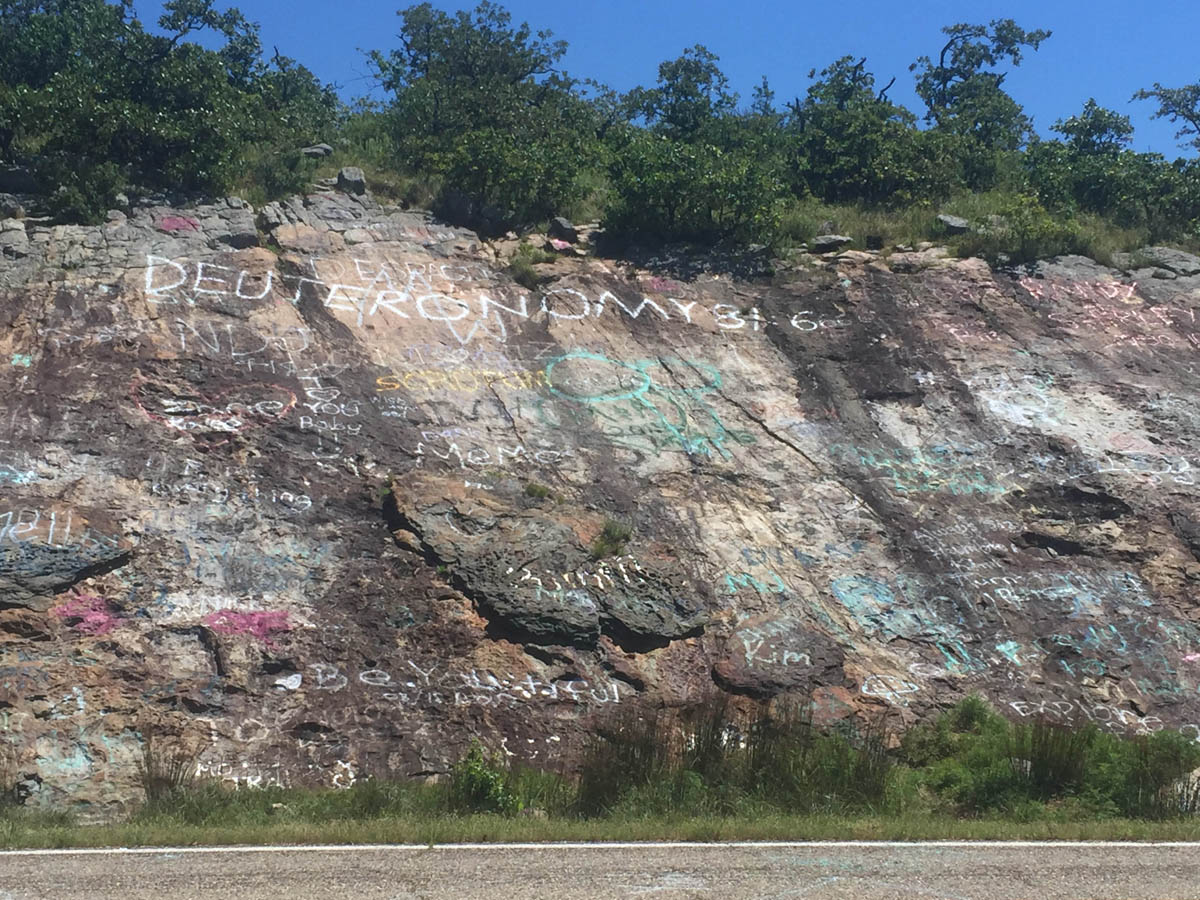2017 William H. Cross Expedition
19-24 June 2017
Ouachita Mountains Biological Station
by Joe MacGown, uploaded on 21 July 2017
The 2017 William H. Cross Expedition was held from 19 to 24 June 2017 at the Ouachita Mountains Biological Station (OMBS) in Polk County, Arkansas. We focused our collecting efforts on the beautiful mountainous Ouachita Mountains Biological Station, but also collected at various sites in the Ouachita National Forest, Queen Wilhelmina State Park, Big Fork Creek Natural Area, and Stone Road Glade Natural Area.

The gorgeous Ouachita Mountains of Arkansas
The Ouachita National Forest, the oldest national forest in the southern United States, occupies 1,784,457 acres (7,221 km2) and includes most of the Ouachita Mountains. The Ouachita Mountains Biological Station is an education and research center located within the national forest that was established in 1962. The station encompasses about 600 acres with elevations ranging from 369 to 622 meters. Overall, the forest community at the station is mixed pine hardwood dominated by shortleaf pine, post oak, black oak, blackjack oak, southern red oak, and sweetgum and dogwood, downy serviceberry, American hornbeam, eastern hophornbeam, and winged elm being common understory trees.
Accommodations at the OMBS were ideal for our group with a large bunkhouse with sleeping for ten, a kitchen and large dining area; another building with a large lab; a couple of small cabins; and the manager's home.
A view of the OMBS bunkhouse
Participants of this year's expedition included MEM employees Richard Brown (director), Terry Schiefer (curator), Joe MacGown (Research Technician), JoVonn Hill (Research Scientist), Ryan Whitehouse (Research Associate), and summer workers Luis Santiago (PhD student), Juan Santiago (undergrad, Puerto Rico), Kyhl Austin (undergrad, Davison College, TN), and Steven Wang (high school student, Houston, TX). Also present during most of the week were Jeff Pittman (OMBS Manager), Laurence Hardy (OMBS Director of the Board), Brad McPherson (OMBS board member), and Vicky Lefevers (OMBS board member).
19 June, Monday
MEM participants arrived at the remote OMBS just before 5 PM on Monday, 19 June, where we met the OMBS folks. After a brief meet and greet, we unloaded our supplies and got to work. The moth crew (Richard, Kyhl, Luis, and Juan) set up the lab for moth spreading, then scouted the immediate area for potential blacklighting spots for the upcoming evening. Terry wasted little time, and by nightfall, he had already put up three Malaise traps and three Lindgren funnel traps. I unloaded the twenty Berlese funnels I had brought and set them up in the lab. Ryan and Steven hung up two Winkler funnels outside. JoVonn jumped right into collecting grasshoppers, ants, and other insects. After getting setup, Ryan and I grabbed bags of sifted litter from nearby and put them on the funnels right away. Meanwhile, Luis and Juan, who had made an earlier grocery run, grilled burger and hotdogs for everyone!

Steven and Ryan setting up Winkler sacks
After supper, we got our gear together for an evening of blacklighting. For those not familiar with blacklighting, basically, we hang white sheets from ropes tied between trees and hang an elongate UV light from it. The UV light (blacklight) is powered by a lawn-mower battery. Numerous night flying insects, especially moths, are attracted to lights, and this a great way to hand collect these species. The insects typically fly to the light, which illuminates the white sheet, and then often rest on the sheet. This makes collecting them quite easy! This evening we had three sheets and lights scattered in the woods, and Vicky had a sheet setup with numerous lights under a large pavilion. Vicky's sheet, with the numerous lights, was up for the entire week and was a great draw for large saturniid moths and other insects. In addition to the sheets, Richard put out a bucket trap in an open powerline cut area. The bucket trap is a passive UV type of trap. Insects that are attracted to the light fall in a funnel into a five-gallon bucket where they are killed with some type of killing agent (in this case, Ethyl Acetate). After a late night of collecting, we called it a night, took care of the insects we had collected, then finally hit the sack!
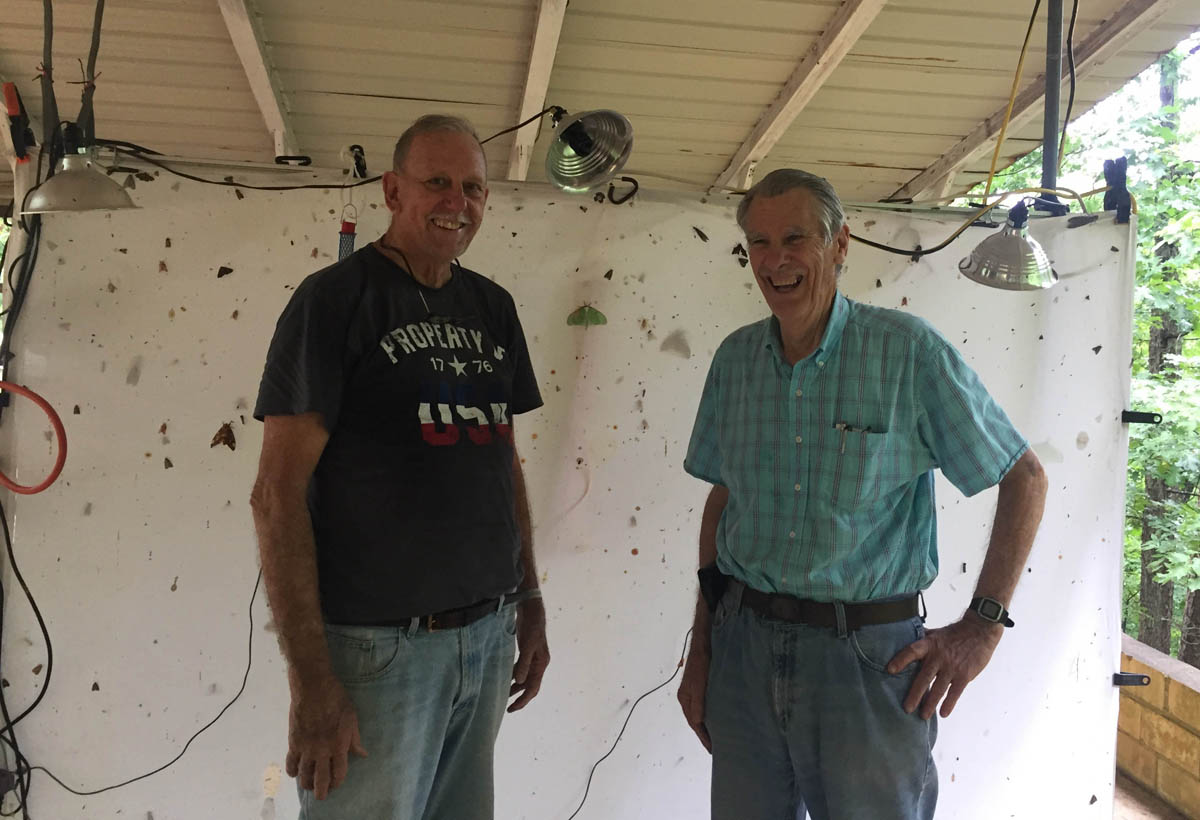
Brad and Laurence in front of Vicky's sheet with numerous lights
20 June, Tuesday
With the exception of Richard, who was up early sorting the bucket trap, Tuesday Morning began with groggy-headed entomologists roaming about the bunkhouse eating cold cereal. Richard and the rest of the moth crew had a day full of wing spreading ahead of them. Meanwhile, the rest of us (JoVonn, Terry, Ryan, Steven, and Joe) ventured forth to collect at some sites in the national forest and Queen Wilhelmina State Park that had been recommended to us by Theo Witsell, botanist/ecologist for the Arkansas Natural Heritage Commission. Our first stop was at a beautiful overlook on Rich Mountain, Polk, in the national forest. After looking at the gorgeous vista, we crossed the opposite side of the road and scaled a semi-steep, graffiti rich slope to access a small, but beautiful stunted oak savanna. We collected numerous species of flies, bees, grasshoppers, ants, and other insects. One of the more interesting ant species collected was Dolichoderus taschenbergi, a blackish colored Dolichoderine ant associated with open habitats, and a species that we seldom find.
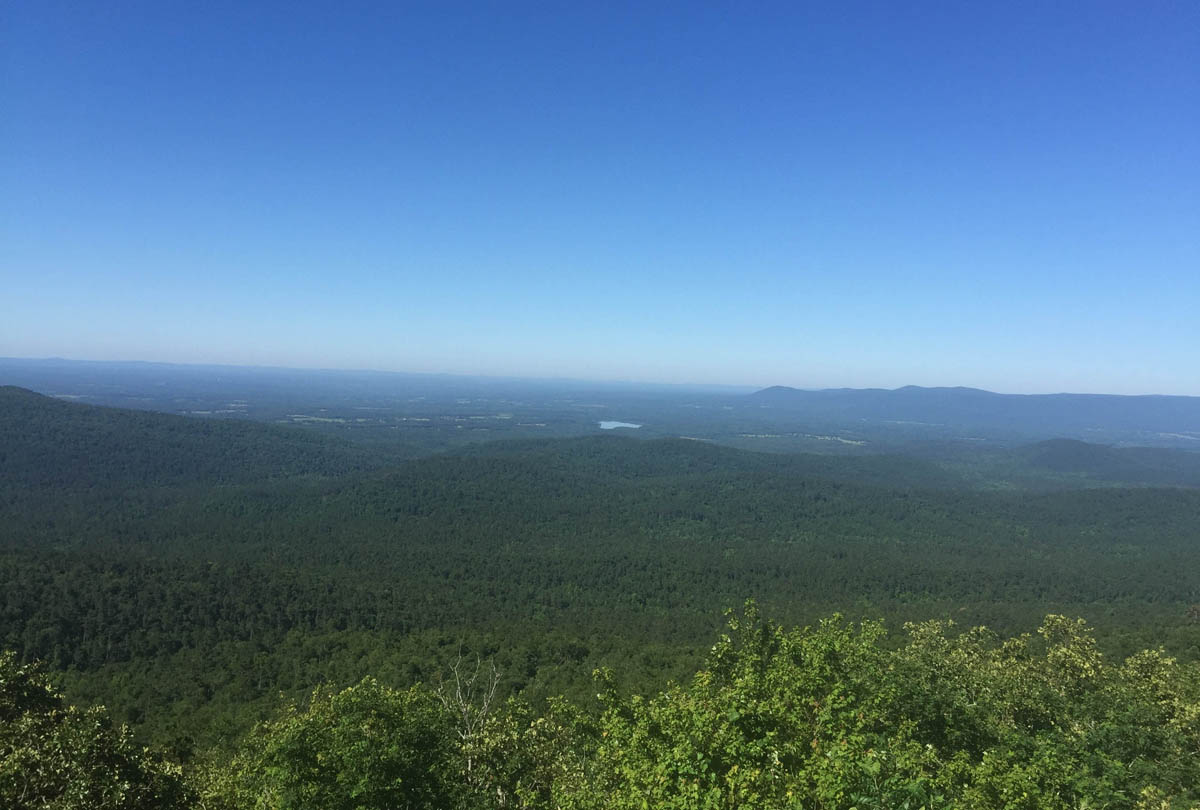
A beautiful view from the overlook
Our next stop was high upon Rich Mountain at a fire tower. The immediate area surrounding the fire tower was an open mowed grass area rimmed by forest. Odorous house ants, Tapinoma sessile,were the dominant ant at the site, with various carpenter ants ants, Formica species, and other ants present as well. Terry hiked farther down the scenic highway searching for flowers and the potential for long-horned beetles on those flowers. After our collecting foray, the rest of us jumped in the truck, picked up Terry down the highway, then headed to a the State-line Trail site in the National Forest that is on the border of Oklahoma and Arkansas. The trail was very short, but the mixed mesic forest was quite beautiful. We flipped rocks looking for ant colonies, swept trail-side vegetation, beat vegetation, and otherwise collected at the site for a brief time before heading to Queen Wilhelmina State Park.
The focal point of the state park is beautiful Queen Wilhelmina Lodge, the "Castle in the Sky" lodge. This first incarnation of this luxury mountain top resort was built in 1898 to house passengers of the Kansas City, Pittsburgh, and Gulf Railroad, and because many of the railroad investors were Dutch, the lodge was named after Queen Wilhelmina of the Netherlands, who was crowned that same year. Due to financial troubles of the railroad, the lodge fell into disrepair and was closed in 1910. A new lodge, which used some of the original rocks, was built in 1963. Unfortunately, the lodge burned down ten years later in 1973. It was rebuilt yet again and opened in 1975. Another series of renovations occurred from 2013 to 2015. Despite our sweaty, dirty appearance, we utilized the very nice restaurant for lunch, before checking out the nearby trails for insects. Our first stop was right outside of the lodge in an open scenic lookout area. This spot was literally jumping with grasshoppers! We then ventured down a nature trail that located on a ridge through a beautiful mixed pine-hardwood forest, where we collected for about an hour.

Near the trailhead at Queen Wilhelmina State Park
As the day wore on, we began on lengthy return through the curvy, mountainous roads of the national forest to the biological station. Along the way back, we made a brief stop at Big Fork Creek Natural Area, located within the national forest and only a few miles from the station. This site was centered around a creek, and although in many ways it did not seem perfect, this would be our blacklight spot for the evening.
Finally, we made it back to the station! The moth crew had spread the wings of many moths! During random time periods, Juan, Luis, and Kyhl also hiked around the property and did some day collecting. Unfortunately, the need to spread the lepidopteran wings while they were fresh meant they did not get to join us for our daily excursions. Upon our return, we were meant with the wonderful aromas from Luis's fantastic cooking! Wow. We feasted on pasta with a savory meat sauce. Oh my. We did not have much to time to relax, however, as it was soon time to put up sheets with MV lights at the Big Fork site. But first, Richard put a bucket trap out near an old quarry site on the station property. Then everyone except JoVonn and I went out to collect at the Big Fork site. We both decided to stay and collect at the sheets at the station. As it turned out, collecting was better at the biological station. Some time near midnight, the others returned and joined us in collecting. Gradually, folks called it quits, put away specimens and went to sleep! A long day.
21 June, Wednesday
Sometime early in the morning, Richard went to the quarry site to retrieve the bucket trap. This was no easy task, as the trail leading there was quite steep. He caught a ride with the station manager on an all terrain vehicle, and had to work hard to keep the trap contents safe on the return. Richard then spent the rest of the morning sorting moths and other insects from the trap. Juan, Luis, and Kyhl once again began their day of spreading moth wings. The rest of us, JoVonn, Terry, Ryan, Steven, and Joe, snagged some breakfast, then jumped into the truck to go investigate some more collecting sites.
After traveling along miles of windy dirt forest roads, we arrived at the Caney Creek Wildlife Management Area, located within the national forest. We collected at a piney glade site on a dry ridge. After collecting for an hour or more, we continued our journey toward the Stone Road Glade Natural Area located in Howard County. Along the way, we spotted some flowering oak-leaved hydrandea bushes near a creek, so, of course, we stopped to collect there. Many of the bushes were difficult to access, but for the flowers were could reach, were rewarded with several species of lepturine cerambycid beetles!

An open mountain top glade at Caney Creek WMA
After collecting a few representative species of beetles from the flowers, we got back on course and headed toward the Stone Road Glade site. Along the way, we passed an adequate looking Mexican restaurant in the small town of Dierks in Howard County. Since it was lunch time and since we were hungry, we gave it a go. We were more than pleased with the food and the very friendly staff! Near the end of the meal, JoVonn told one of the waiters it was my birthday, so I got to wear the festive birthday sombrero, was rewarded with tasty sopapillas, and was serenaded by the wait staff. Ole'. Well, we all ate a lot and could have used a nap. But, nonetheless, we departed. On the way to the truck, we stopped to look for ants at the lone and sad looking oak tree in the parking lot. We were surprised to find numerous dealate queen Asian needle ants (Brachyponera chinensis) crawling on the tree trunk! This invasive species is common along the east coast in North Carolina, South Carolina, and parts of Georgia and appears to be steadily spreading across the country. Our collection here represents the first record of this species from Arkansas.

Oak tree in Dierks where we collected Asian needle ants
After collecting a series of needle ants and a few other native species in Dierks, we continued onward to the glade site. Finally, after more miles of windy forest roads, we arrived at the natural area. Although it was relatively small, it was lush with prairie/glade vegetation, with many flowers in bloom. Most of the area surrounding the glade was cut-over fores, though the edges of the glade itself was intact forest that showed signs of a recent burn. Apparently the glade is regularly burned, which is great for some of the plants, but not so great for insects that are specifically tied to the habitat. Indeed, this appeared to be the case here. Although the glade was abuzz with bees, wasps, flies, and other insects, these insects were predominately generalist species, rather than glade specific insects. In essence, despite the rich flora, because the the glade habitat here is burned so often and surrounded by clearcut forests, it is essentially functions as disturbed roadside habitat. The dominant ants also bore this theory out, with fire ants being especially abundant. We even found Asian needle ants to be common at the edges of the glade.
Well, it was a long drive for less than spectacular results, but, finding the needle ants in western Arkansas was noteworthy! Back on the road for the longish trip to the station. As we drove through the beautiful national forest, we scouted for potential blacklighting spots. But, most the sites were so far away from the station, we nixed them. We did eventually stop at the gorgeous Albert Pike Recreation Area, located along a river. We stayed for a little while doing some general collecting and soaking in the scenic beauty! But, the day was wearing on, so we called it quits and made our way back.
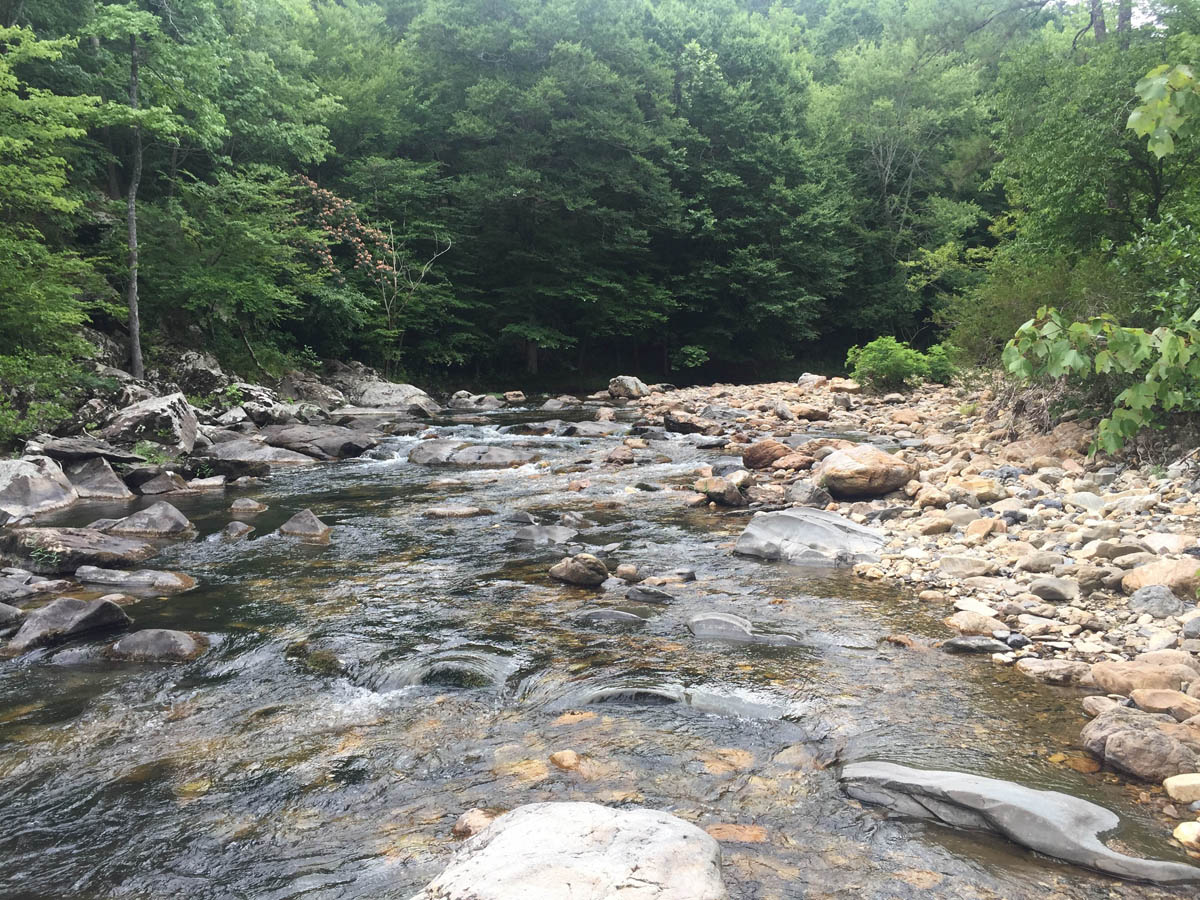
Creek at Albert Pike Recreation Area
Of course, our wonderful Luis had supper ready when we got back to the station! Then back to work. I put my litter and soil samples on the Berlese funnels, and we all got ready for another night of blacklight collecting. As in the previous night, JoVonn and I stayed at the station to collect, and the others headed to Butcherknife Trail, a spot located on the OMBS property. They also put a bucket trap out at the site. After 3-4 hours of collecting at the sheets at Butcherknife, the rest of the crew returned to the station to collect at the sheets there and then take care of specimens.
22 June, Thursday
Richard once again was up early to pick up the bucket trap and sort through it. Eventually, the rest of us arose and got started. Today was gloomy with rain in the forecast. Rain is not the forecast we want. With that in mind, we decided today would be a great day to concentrate on the station property. With scattered storms all day, our collecting consisted of random forays into the forest with hasty retreats if the rain became too hard. Obviously, collecting in the rain is not ideal, but for some groups, including some ants, its still possible. For me, this meant flipping over rocks, tearing open rotting wood, and trying to find somewhat dry leaf litter to search for ants. It was also a good day for us to sort insects and spreading insects, and even afforded us some down time.
Luis spent at least some of this wet and lazy afternoon cooking another tremendous feast. Tonight's meal was some type of Puerto Rican Pork and vegetable. Amazing. We were definitely spoiled on this collecting trip with Luis's culinary talents.
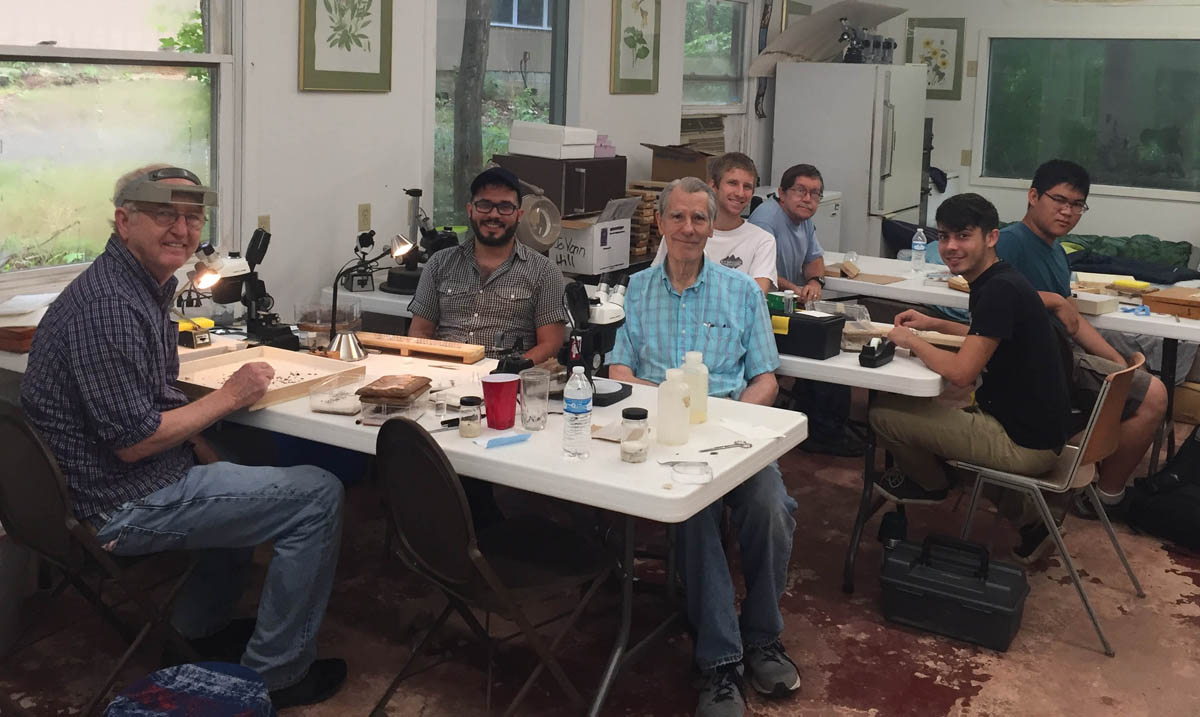
Some of the MEM crew in the lab with OMBS Board Director Laurence Hardy
Later in the day, Steven ventured off collecting on his own up past the old quarry site. He walked quite a ways up a steep trail, collecting here and there, then returned to the lab near 7 PM. I looked at some of the ants he picked up and was surprised to see a few specimens of a species I did not recognize. With very poor cell service, it was frustrating trying to figure it out. At first glance in the vial I thought it was a ponerine, but after pulling a specimen out and looking at it under a low power microscope, I realized it was a doryline species, but not something I was familiar with. I asked Steven for coordinates and info about how he collected the ants. Then I headed up there myself, hoping to make a quick trek there and back by dark, which was no easy task due to the steepness and roughness of the trail. With the rain, the trail was even harder to walk on than usual. My GPS was working intermittently, but I finally got to a site that I thought was Steven's awesome ant site. Well, I looked under every rock I could find (he found the ants under a good sized rock about 0.5 m in longest diameter) and I sifted a huge quantity of dirt and leaf litter. I found plenty of ants, but not the one I wanted! Oh well. I might have stayed longer, but it was raining, I was in the middle of nowhere, and it was almost dark. I made my way back down the steep, wet, and rocky trail as fast as possible, while trying not to break a leg! I made it back sometime after 9 PM, soaked and dirty, with bags of soil to put on the funnels.

Joe and JoVonn post collecting
JoVonn had also been out grabbing litter samples and had returned just before me. He looked equally bedraggled! Everyone else was occupied pinning insects, mostly moths. Richard did not put out a bucket trap this evening. And, due to the rain, we decided to confine our black light and sheet collecting to the station, with Vicky's elaborate setup being the prime spot since it was under a pavilion roof. We also had one sheet setup just outside the lab. To keep us on our toes, a copperhead spent some time near this sheet this evening! Collecting this evening was more social than serious, but by the end of the evening we still pulled in quite a bit. The large orangish colored male army ants, Neivamyrmex pilosus, were again relatively common, as they had been each night at the sheets at the station. These male army ants had been teasing me all week, because I knew they must be colonies present, but thus far they had alluded me.
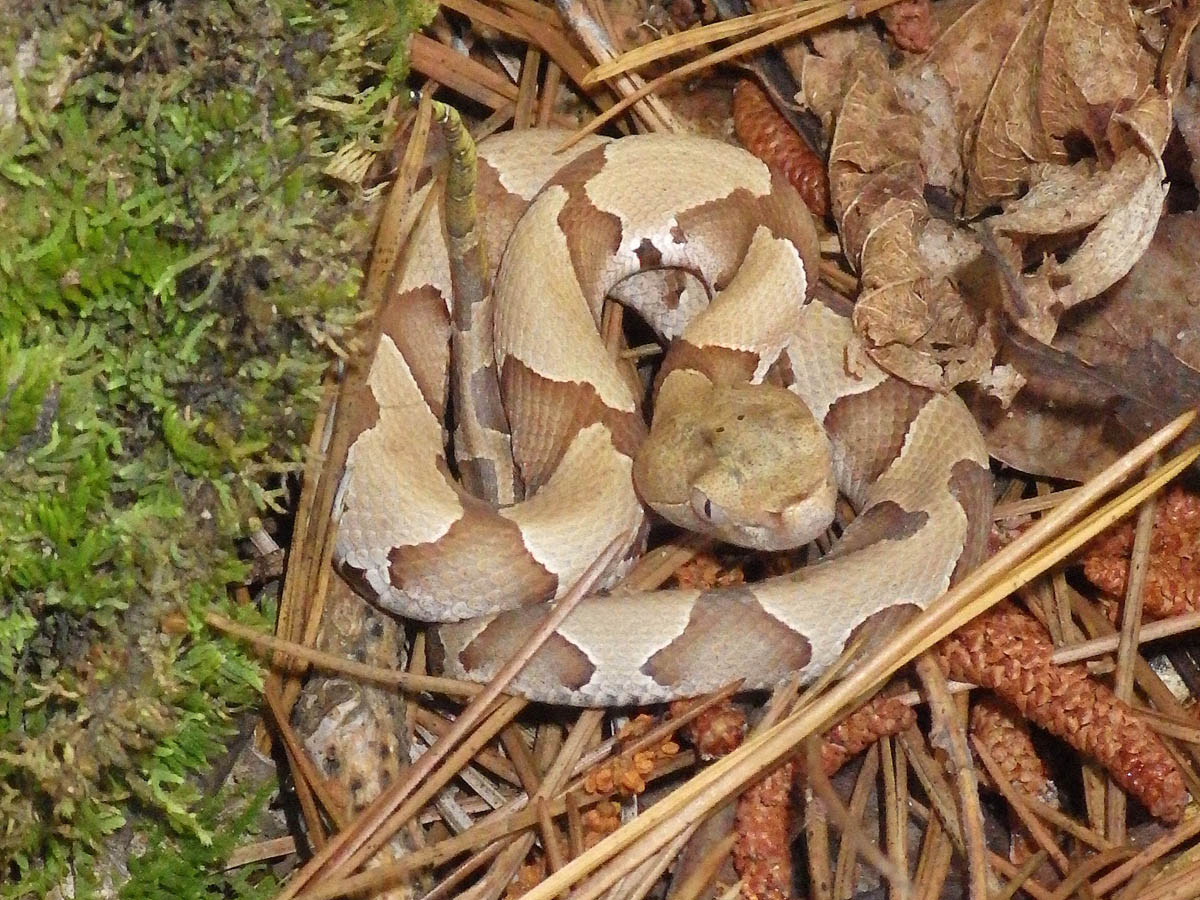
Copperhead snake (photo by JoVonn Hill)
23 June, Friday
Another rainy day. Apparently, we receiving the after effects of a tropical storm. So, much like the previous day, most of us spent the day pinning and collecting on the station property. For some reason, I had a bit more cell service this morning, so I was able to get a better idea of which ant Steven collected the day before. The species in question turned out to be a rarely collected southwestern species called Syscia augustae! Needless to say, I was still very interested in finding some more of these ants if possible, so I grabbed Steven and we headed back to his site. It turned out that I did not actually collect at the site he did, and his site was even higher up! Upon arriving, we upturned the rock that cover the small colony he had found. He noted that the common woodland big-headed ant, Pheidole dentata, was also nesting under the same rock. Unfortunately, the ants had vacated. We systematically turned over every rock in the vicinity hoping to find them, but to no avail. I collected numerous bags of soil and leaf litter for Berlese extraction, and we sifted through the top soil layer and litter in the area. No luck. However, we did find a small colony of the army ant Neivamyrmex pilosus, which was the species we had collected males of at the lights. Interestingly, males are orangish and workers are almost black. We poked around some more, collecting ants interesting species such as the Dracula ant Stigmatomma pallipes and others. I kicked over a very dead tree, or what was left of it, and in doing so revealed a huge colony of yet another army ant, Neivamyrmex opacithorax. This colony had a wide range of sizes of yellowish-orange workers present, and they were not pleased that I disrupted their colony. I collected a large series of them, but the cost was high as I was stung numerous times by these aggressive little ants!
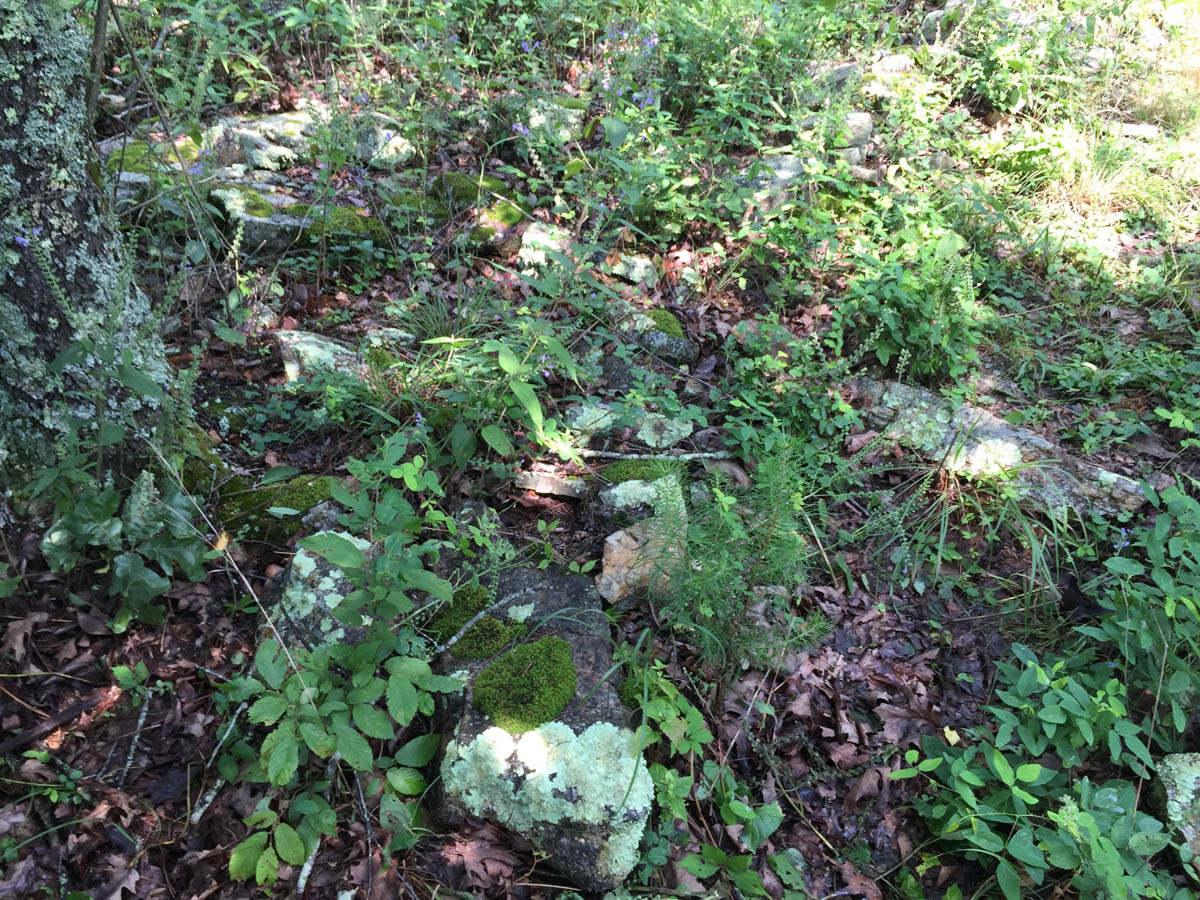
The area where the Syscia were discovered
We finally called it quits and headed back to the lab to run the Berleses. It was quite interesting that this one small site was home to three different doryline ants. Fantastic! After lunch, we got back to collecting with Steven, Ryan, JoVonn, and I roaming the station land looking for insects. Terry spent the afternoon taking down his Malaise and Lindgren funnel traps. By supper, we were all pretty beat. The moth crew was weary too after a long week of late nights and spreading moths each day. We had leftovers tonight, which were almost as good as when first prepared! Then most of the crew except Richard, JoVonn, and I went to a site on Rich Mountain to blacklight. This was an interesting spot on the side of the mountain with great visibility. While there, they put out a bucket trap as well, which they took down after sheet collecting.
While folks were blacklighting, I spent some time breaking down the Berlese funnels and cleaning up the mess I had made! Richard did all he could to finish spreading moths. JoVonn and I casually collected at the pavilion lights. Later, the rest of our crew returned, and finally we called it a night.
24 June, Saturday
Departure! After the five days of collecting, it was time to begin the trip back to MSU. We said our goodbyes to Vicky and Jeff (Laurence and Brad had left the day before), loaded up our vehicles, and headed out.
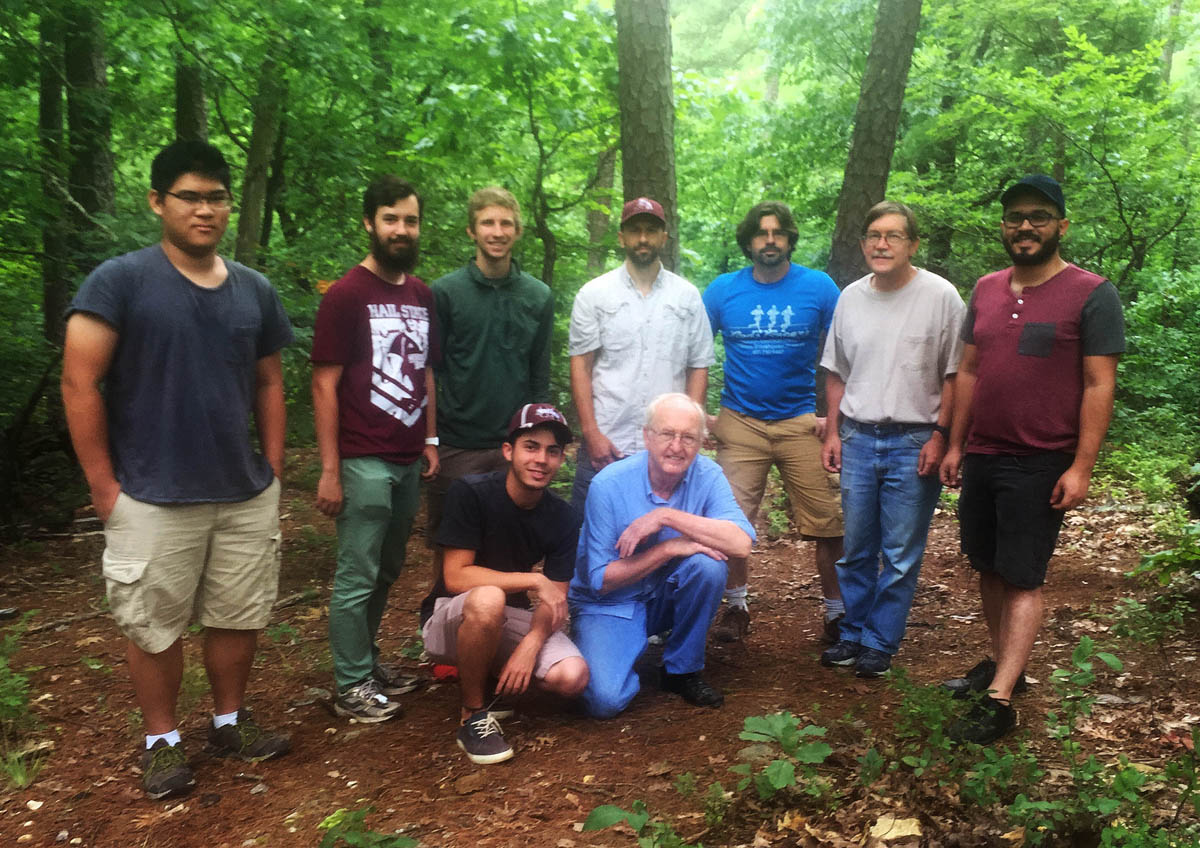
From left, back row: Steven Wang, Ryan Whitehouse, Kyhl Austin, JoVonn Hill, Joe MacGown,
Terry Schiefer, and Luis Santiago. Front row, kneeling: Juan Santiago, and Richard Brown.
Species Lists
Ants Collected during the 2017 William H. Cross Expedition
2017 William H. Cross - Collecting Localities
Ouachita Mountains Biological Station
Bunkhouse and lab area (BL, Bucket Trap, Malaise, Lindgren, general, 19-24 June 2017-all MEM collectors)
ARK., Polk Co
Ouachita Mts. Biol. Sta.
34°27'46"N 93°59'55"W – powerline Box
34°27'46"N 93°59'53"W – sheets near lab
mixed hardwood
pine forest
W.H.Cross Expedition
Slate Mine/Quarry Site (RLB, bucket trap, 20 June; and general collecting, others, 20-23 June)
ARK., Polk Co
Ouachita Mts. Biol. Sta.
34°27’29”N 93°59’56”W
mixed hardwood
pine forest
W.H.Cross Expedition
Ridge Trail up from Slate Mine Quarry with army ants (SW and JAM, litter, ants, 22-23 June 2017)
ARK., Polk Co
Ouachita Mts. Biol. Sta.
34°27'29"N 94°00'12"W
oak-cherry glade
W.H.Cross Expedition
Butcherknife Trail (RLB, KAA, JAS, LYS, TLS, RJW – blacklight, bucket trap, 21 June)
ARK., Polk Co.
Ouachita Mts. Biol. Sta.
34°28’4”N 94°00’40”W
mesic mixed
hardwood pine forest
W.H.Cross Expedition
Malaise and Lindgren Site 1, near creek
(T.L.Schiefer, 19-23 June)
ARK., Polk Co.
Ouachita Mts. Biol. Sta
34°27'46"N 93°59'48"W
hardwood/pine forest
near creek
W.H.Cross Expedition
Malaise and Lindgren Site 2, powerline right (north) of workshed
(T.L.Schiefer, 19-23 June)
ARK., Polk Co.
Ouachita Mts. Biol. Sta.
34°27'47"N 93°59'55"W
hardwood/pine forest
on powerline
W.H.Cross Expedition
Malaise and Lindgren Site 3, on powerline left (south) of work shed
(T.L.Schiefer, 19-23 June)
ARK., Polk Co.
Ouachita Mts. Biol. Sta.
34°27'46"N 93°59'55"W
hardwood/pine forest
on powerline
W.H.Cross Expedition
Ouachita National Forest Sites
Ouachita National Forest Site 1, Rich Mountain Scenic Overlook,, Sky Island (JAM, JGH, TLS, SW, RJW -general collecting, 20 June)
ARK., Polk Co.
Ouachita Natl. For.
34°39'19"N 94°17'12"W
stunted oak savanna
woodland
W.H.Cross Expedition
Ouachita National Forest Site 2, RIch Mountain Fire Tower site (JAM, JGH, TLS, SW, RJW -general collecting, 20 June)
ARK., Polk Co.
Ouachita Natl. For.
34°40'28"N 94°19'44"W
disturbed grassy overlook
W.H.Cross Expedition
Ouachita National Forest Site 3, Stateline Trail, Arkansas side (JAM, JGH, TLS, SW, RJW -general collecting, 20 June)
ARK., Polk Co.
Ouachita Natl. For.
34°41'38"N 94°27'20"W
mesic mixed hardwood
pine forest
W.H.Cross Expedition
Ouachita National Forest Site 4, Stateline Trail, Oklahoma side (JAM, JGH, TLS, SW, RJW -general collecting, 20 June)
OKLA., Le Flore Co.
Ouachita Natl. For.
34°41’37”N 94°27’21”W
mesic mixed hardwood
pine forest
W.H.Cross Expedition
Ouachita National Forest Site 5, Caney Creek WMA (JAM, JGH, TLS, SW, RJW -general collecting, 21 June)
ARK., Polk Co.
Ouachita Natl. For.
34°23’18”N 94°00’48”W
piney glade
W.H.Cross Expedition
Ouachita National Forest Site 6, Hydrangea site on roadside (JAM, JGH, TLS, SW, RJW -general collecting, 21 June)
ARK., Polk Co.
Ouachita Natl. For.
34°23'15"N 94°01'24"W
Hydrangea arborescens
at edge of mesic mixed
hardwood-pine forest
W.H.Cross Expedition
Ouachita National Forest Site 7, Albert Pike Rec. Area, Montgomery Co. (JAM, JGH, TLS, SW, RJW -general collecting, 21 June, river site)
ARK., Montgomery Co.
Ouachita Natl. For.
34°22’55”N 93°53’05”W
rocky river by
hardwood pine forest
W.H.Cross Expedition
Ouachita National Forest Site 9, Mountain top by scenic overlook (R.J.Whitehouse,J.G.Hill, general collecting)
ARK., Polk Co.
Ouachita Natl. For.
34°25’37”N 94°03’16”W
23 June 2017
R.J.Whitehouse,J.G.Hill
wooded mountain top
W.H.Cross Expedition
Ouachita National Forest Site 10, Rich Mountain trail (General collecting 20 June; bucket trap, 23 June, K.A.Austin)
ARK., Polk Co.
Ouachita Natl. For.
34°38'05"N 94°15'12"W – gen. collecting site
34°38'11"N 94°15'20"W - Bucket trap site
hardwood-pine forest
on mountain slope
W.H.Cross Expedition
Terry's Site 1 - Rich Mountain, Ouachita National Forest Site 11 (T.L.Schiefer, collected on Helianthus)
ARK., Polk Co.
Ouachita Natl. For.
34°39'49"N 94°17'37"W
on flowers of
Helianthus sp.
W.H.Cross Expedition
Terry's Site 2 - Rich Mountain, Ouachita National Forest Site 12 (T.L.Schiefer, collected on Daucus)
ARK., Polk Co.
Ouachita Natl. For.
34°40'00"N 94°17'56"W
on flowers of
Daucus carota
W.H.Cross Expedition
Terry's Site 3 - Rich Mountain, Ouachita National Forest Site 13 (T.L.Schiefer, collected on Helianthus)
ARK., Polk Co.
Ouachita Natl. For.
34°40'02"N 94°18'11"W
on flowers of
Sambucus canadensis
W.H.Cross Expedition
Wilhelmina State Park
Lovers Leap trail (near west trail head), (JAM, JGH, TLS, SW, RJW -general collecting, 20 June; KAA, JAS, LYS, TLS, RJW – blacklight, 23 June)
ARK., Polk Co.
Queen Wilhelmina S.P.
34°41’00”N 94°22’24”W- general coll. site. open
(34°41’02”N 94°22’10”W – woods trailed/ sheets & gen. collecting
mixed hardwood
pine forest
W.H.Cross Expedition
Dierks, Howard County
Howard County, Dierks Site (JAM, JGH, TLS, SW, RJW –ants on tree near Mexican restaurant, 21 June; Camponotus and Asian needle ants)
ARK., Howard co.
Dierks
34°07'40"N 94°00'58"W
on and at base of
Quercus virginiana at
parking lot edge
W.H.Cross Expedition
Big Fork Creek Natural Area (RLB, KAA, JAS, LYS, TLS, RJW – blacklight, 20 June)
ARK., Polk Co.
Big Fork Creek N.A.
34°29’51”N 93°58’22”W
mixed hardwood
pine forest
W.H.Cross Expedition
Stone Road Glade N.A.
Stone Road Glade N.A., Howard Co. (JAM, JGH, TLS, SW, RJW -general collecting, 21 June)
ARK., Howard Co.
Stone Road Glade N.A.
34°04’45”N 93°54’20”W
prairie/glade
W.H.Cross Expedition




